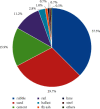Life Cycle Assessment of Construction and Demolition Waste from Railway Engineering Projects
- PMID: 35528368
- PMCID: PMC9071954
- DOI: 10.1155/2022/6145755
Life Cycle Assessment of Construction and Demolition Waste from Railway Engineering Projects
Abstract
Railway engineering generates large amounts of construction and demolition waste (CDW). To quantify the amount of CDW generated from railway engineering projects throughout the whole life cycle, a process-based life cycle assessment model is proposed in this paper. The life-cycle CDW is divided into four parts: CDW from off-site transportation of construction materials (OSTCM), CDW from site operation wastage of construction materials (SOWCM), discard ballast from roadbeds, stationyard, bridges and tunnels (DB), and CDW from reparation and renewal of aging components (RRAC). Yun-Gui Railway is selected as a case study to validate the developed model, and an uncertainty analysis is conducted with Oracle Crystal Ball software. The results show that between 175 and 311 million tons of CDW is generated throughout the whole life cycle of Yun-Gui Railway. DB is the largest component of the life-cycle CDW from railway engineering projects. This indicates the negative environmental impacts of railway construction can be significantly mitigated by optimizing the location of ballast disposal sites and developing suitable landfill proposals. Also, the CDW generated by wastage of construction materials during off-site construction and site operation is important in waste management in railway engineering projects, in which rubble, sand, and cement have the high potential for waste reduction. Findings from this study can contribute to the knowledge body as well as the engineering practice in green railways.
Copyright © 2022 Jianling Huang et al.
Conflict of interest statement
All authors declare that they have no conflicts of interest.
Figures
Similar articles
-
Comparison of scenarios for the integrated management of construction and demolition waste by life cycle assessment: A case study in Brazil.Waste Manag Res. 2016 Oct;34(10):1026-1035. doi: 10.1177/0734242X16657605. Epub 2016 Jul 20. Waste Manag Res. 2016. PMID: 27443296
-
Life Cycle Assessment of Construction and Demolition Waste Management in Riyadh, Saudi Arabia.Int J Environ Res Public Health. 2022 Jun 16;19(12):7382. doi: 10.3390/ijerph19127382. Int J Environ Res Public Health. 2022. PMID: 35742631 Free PMC article.
-
Identification of critical factors in construction and demolition waste recycling by the grey-DEMATEL approach: a Chinese perspective.Environ Sci Pollut Res Int. 2020 Mar;27(8):8507-8525. doi: 10.1007/s11356-019-07498-5. Epub 2020 Jan 6. Environ Sci Pollut Res Int. 2020. PMID: 31907809
-
Managerial Areas of Construction and Demolition Waste: A Scientometric Review.Int J Environ Res Public Health. 2018 Oct 24;15(11):2350. doi: 10.3390/ijerph15112350. Int J Environ Res Public Health. 2018. PMID: 30356018 Free PMC article.
-
Developments in life cycle assessment applied to evaluate the environmental performance of construction and demolition wastes.Waste Manag. 2016 Apr;50:151-72. doi: 10.1016/j.wasman.2016.01.036. Epub 2016 Feb 23. Waste Manag. 2016. PMID: 26919970 Review.
References
-
- Jain S., Singhal S., Jain N. K., Bhaskar K. Construction and demolition waste recycling: Investigating the role of theory of planned behavior, institutional pressures and environmental consciousness. Journal of Cleaner Production . 2020;263 doi: 10.1016/j.jclepro.2020.121405.121405 - DOI
-
- Wu Z., Yu A. T. W., Poon C. S. Promoting effective construction and demolition waste management towards sustainable development: A case study of Hong Kong. Sustainable Development . 2020;28(6):1713–1724. doi: 10.1002/sd.2119. - DOI
-
- Wu H., Zuo J., Zillante G., Wang J., Yuan H. Status quo and future directions of construction and demolition waste research: A critical review. Journal of Cleaner Production . 2019;240 doi: 10.1016/j.jclepro.2019.118163.118163 - DOI
-
- Li Y., Zhang X., Ding G., Feng Z. Developing a quantitative construction waste estimation model for building construction projects. Resources, Conservation and Recycling . 2016;106:9–20. doi: 10.1016/j.resconrec.2015.11.001. - DOI
-
- Rondinel-Oviedo and D. R. Construction and demolition waste management in developing countries: A Diagnosis from 265 construction sites in the Lima Metropolitan area. International Journal of Construction Management . 2021;1-12 doi: 10.1080/15623599.2021.1874677. - DOI
MeSH terms
LinkOut - more resources
Full Text Sources
Miscellaneous





